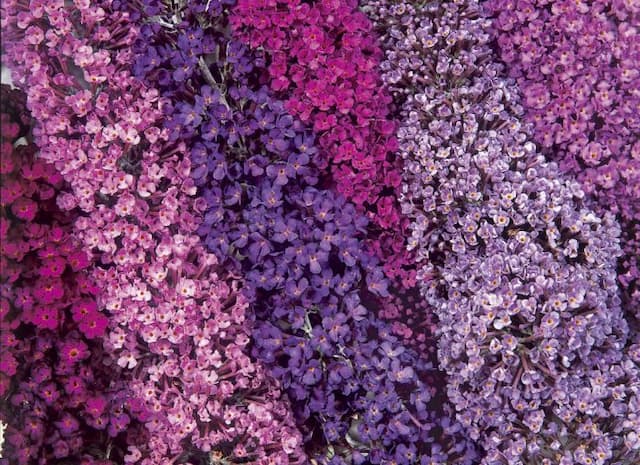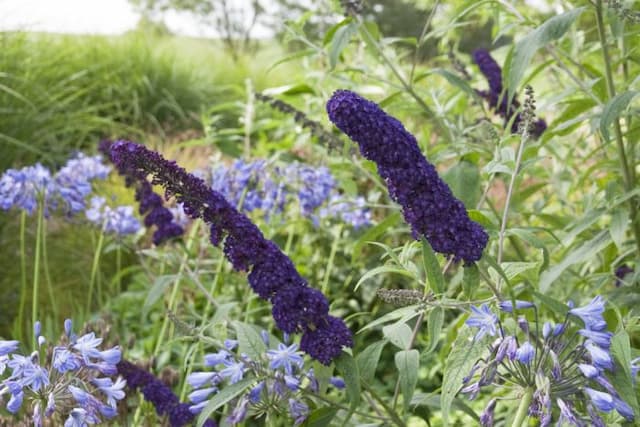Butterfly Bush Buddleja davidii 'Gonglepod'

ABOUT
The Buddleja davidii 'Gonglepod', commonly known as the Butterfly Bush, is a highly ornamental shrub characterized by its lush appearance and attractiveness to butterflies. It possesses arching branches that bear lance-shaped leaves. The foliage typically exhibits a gray-green color, providing a soft backdrop for the vibrant blooms. This Butterfly Bush variety is renowned for its abundant flower spikes, which present a burst of color throughout the blooming season. The flowers are small, tubular, and closely packed in long, conical clusters. This particular cultivar often displays flowers in shades that can range from deep purple to lilac, with each floret marked by a bright orange eye at its center, adding an eye-catching contrast. These blossoms emit a sweet fragrance that is delightful to both people and pollinators, making it a staple for pollinator-friendly gardens. While this description does not delve into specifics regarding the plant's size, the overall form of the Buddleja davidii 'Gonglepod' is that of a robust and well-rounded shrub that becomes a focal point in any garden setting when in full bloom, due to its vibrant and dense flower spikes.
About this plant
 Names
NamesFamily
Scrophulariaceae
Synonyms
Summer Lilac, Butterfly Bush, Orange Eye
Common names
Buddleja davidii 'Gonglepod'.
 Toxicity
ToxicityTo humans
Butterfly bush (Buddleja davidii 'Gonglepod') is not considered highly toxic to humans. However, like many plants, it can cause mild gastrointestinal discomfort if ingested in large quantities. Skin contact with the plant might also cause irritation in some individuals with sensitive skin. It is always a good practice to avoid ingesting parts of ornamental plants due to the potential for unknown toxicities.
To pets
Butterfly bush (Buddleja davidii 'Gonglepod') is generally not regarded as toxic to pets such as dogs and cats. If a pet were to consume parts of the plant, they might experience mild gastrointestinal upset, but serious toxicity is unlikely. Always monitor pets to prevent them from eating large quantities of any non-food plant, and consult a veterinarian if you suspect your pet is reacting adversely after consuming plant material.
 Characteristics
CharacteristicsLife cycle
Perennials
Foliage type
Deciduous
Color of leaves
Green
Flower color
Varies
Height
6-8 feet (1.8-2.4 meters)
Spread
4-5 feet (1.2-1.5 meters)
Plant type
Shrub
Hardiness zones
5-9
Native area
China
Benefits
 General Benefits
General Benefits- Attracts Pollinators: Buddleja davidii, commonly known as Butterfly Bush, is known for attracting a variety of pollinators including butterflies, bees, and hummingbirds, thereby supporting the local ecosystem.
- Easy to Grow: It is considered a low-maintenance plant which is easy to grow in a range of soil types, and it's tolerant of urban pollution and tough conditions.
- Drought Tolerance: Once established, the Butterfly Bush is relatively drought-resistant, making it suitable for areas with water restrictions or low rainfall.
- Fast Growth: The plant tends to grow quickly, providing a fast solution for adding greenery and filling gaps in the landscape.
- Aesthetic Appeal: With its long, arching branches and conical clusters of flowers that come in a variety of colors, it adds visual interest to gardens.
- Privacy Screen: Due to its size and density, it can be used to create a natural privacy screen or to camouflage unsightly areas.
- Wildlife Shelter: Its branches and foliage offer shelter for birds and small wildlife, enhancing biodiversity in the garden.
- Seasonal Interest: The Butterfly Bush blooms in the summer and often continues to provide color and interest into the fall season.
 Medical Properties
Medical PropertiesThis plant is not used for medical purposes.
 Air-purifying Qualities
Air-purifying QualitiesThis plant is not specifically known for air purifying qualities.
 Other Uses
Other Uses- Buddleja davidii, commonly known as Butterfly Bush, can be used as a natural dye for fabrics, giving them a range of soft green and yellow hues depending on the mordant used.
- The wood of the Butterfly Bush can be utilized for making small, handcrafted items such as decorative ornaments or carved trinkets.
- Due to its rapid growth and straight stems, Butterfly Bush can be employed in creating temporary stakes for supporting other plants in a garden setting.
- Dried Butterfly Bush branches can be used in flower arrangements to provide a unique texture and height to the composition.
- Some artisans may use the bark and wood shavings of Butterfly Bush for smoking food, imparting a subtle flavor to the smoked goods.
- Butterfly Bush can act as a natural fence or barrier in landscaping to delineate spaces or provide privacy due to its dense growth habit.
- The flowers of the Butterfly Bush can be steeped in oil to create an aromatic infusion for use in homemade potpourri or sachets.
- Butterfly Bush is often used in photography and painting as a preferred subject because of its vibrant and attractive blooms.
- The extensive root system of Butterfly Bush can help stabilize soil on slopes and prevent erosion in certain landscapes.
- Leaves from Butterfly Bush can be used in compost piles as a green material, adding nutrients and aiding in the decomposition process.
Interesting Facts
 Feng Shui
Feng ShuiButterfly Bush is not used in Feng Shui practice.
 Zodiac Sign Compitability
Zodiac Sign CompitabilityButterfly Bush is not used in astrology practice.
 Plant Symbolism
Plant Symbolism- Regeneration and Renewal: Buddleja davidii, commonly known as the Butterfly Bush, has the ability to rapidly grow back even after being cut to the ground, symbolizing one's ability to rebound and renew just as nature does.
- Attraction and Magnetism: The Butterfly Bush is known for its potent ability to attract butterflies, bees, and other insects, representing the magnetic pull and allure one may hold.
- Transformation: Since the plant attracts butterflies, which are a symbol of transformation, Butterfly Bushes may represent change and the beauty in evolving into something new.
- Adaptation: This plant can thrive in a variety of conditions, reflecting the adaptability and resilience in harsh or changing environments.
 Water
WaterThe Butterfly Bush (Buddleja davidii 'Gonglepod') should be watered deeply to ensure the root zone is thoroughly moistened, particularly during its first growing season to establish a deep, extensive root system. Once established, water the plant generously whenever the top couple inches of soil feel dry to the touch, typically about once a week during the growing season. Cutting back on watering as the plant goes dormant during cooler months is advisable. In terms of quantity, aim for about 1 to 1.5 gallons per watering for a medium-sized shrub, adjusting as necessary for your specific climate and soil conditions. During hot, dry spells, additional watering may be necessary to prevent stress.
 Light
LightThe Butterfly Bush prefers full sun conditions for optimal growth and blooming. It should be placed in a location where it receives at least 6 to 8 hours of direct sunlight daily. Avoid placing it in heavily shaded areas as this can reduce flowering and make the plant more susceptible to diseases. Morning sun with some afternoon shade can also be beneficial, particularly in extremely hot climates.
 Temperature
TemperatureThe Butterfly Bush is adaptable to a variety of temperature conditions but thrives best between 60°F and 90°F. It can survive minimum winter temperatures down to around -20°F, making it suitable for USDA hardiness zones 5 through 9. Ensuring good soil drainage can also protect the roots during colder temperatures.
 Pruning
PruningPruning the Butterfly Bush encourages healthy growth and abundant flowering. Prune in late winter or early spring before new growth begins, cutting back the previous year's growth to about 12 inches from the ground. This practice helps to maintain an attractive shape and size and to remove any dead or diseased wood. Annual pruning is recommended for optimal plant health and bloom production.
 Cleaning
CleaningAs needed
 Soil
SoilButterfly Bush requires well-drained soil with a pH of 6 to 7. A good soil mix for Butterfly Bush is one part loam, one part peat moss or compost, and one part perlite or coarse sand to ensure proper drainage. Regular fertilization can encourage healthier growth and flowering.
 Repotting
RepottingButterfly Bush typically does not require frequent repotting and can be repotted every 2 to 3 years. It is best to repot in early spring before the onset of new growth, using the aforementioned soil mix.
 Humidity & Misting
Humidity & MistingButterfly Bush is adaptable to a wide range of humidity levels and does not require any special humidity considerations. Average outdoor humidity is suitable for this plant, making it quite resilient.
 Suitable locations
Suitable locationsIndoor
Ensure full sun exposure and well-draining soil.
Outdoor
Plant in full sun, prune in late winter.
Hardiness zone
5-9 USDA
 Life cycle
Life cycleBuddleja davidii 'Gonglepod', commonly known as Butterfly Bush, begins its life cycle when seeds germinate in favorable conditions, which involves a well-drained soil medium and abundant sunlight. Seedlings emerge with their first set of true leaves and continue to grow, provided with adequate water and nutrients. As the plant matures into a young bush, it develops woody stems and an abundance of foliage. During the growing season, typically in summer, the Butterfly Bush produces conical clusters of fragrant flowers that attract butterflies and other pollinators, initiating the reproductive stage. After pollination, the flowers develop into small capsules containing seeds which, when mature, are dispersed by wind or wildlife, completing the cycle. In colder climates, Butterfly Bush may die back to the ground during winter but will typically resprout from its roots in spring.
 Propogation
PropogationPropogation time
Spring-Early Summer
The most popular method for propagating Butterfly Bush (Buddleja davidii 'Gonglepod') is through softwood cuttings. This process is typically done in late spring or early summer when new growth is green and flexible. Cuttings about 6 inches (15 cm) long are taken from the current year’s growth, ensuring a few sets of leaves are present. The lower leaves are removed, and the cut end is dipped in rooting hormone to encourage root development. The cutting is then planted in a pot filled with a well-draining soil mix, with the lower half of the stem buried. The soil should be kept moist but not soggy, and the pot should be placed in a bright area but out of direct sunlight. Roots generally form within a few weeks, after which the new plants can be gradually acclimatized to outdoor conditions.


![Butterfly bush [Adonis Blue]](/_next/image?url=https%3A%2F%2Fplants-admin.emdemapps.com%2Fimages%2Fplants%2F%2Fimages%2F604b56e58f983.png&w=640&q=75)


![Butterfly bush [Buzz Ivory]](/_next/image?url=https%3A%2F%2Fplants-admin.emdemapps.com%2Fimages%2Fplants%2F%2Fimages%2F604b57987dfa8.png&w=640&q=75)
![Butterfly bush [Camberwell Beauty]](/_next/image?url=https%3A%2F%2Fplants-admin.emdemapps.com%2Fimages%2Fplants%2F%2Fimages%2F604b5ead04c12.png&w=640&q=75)


